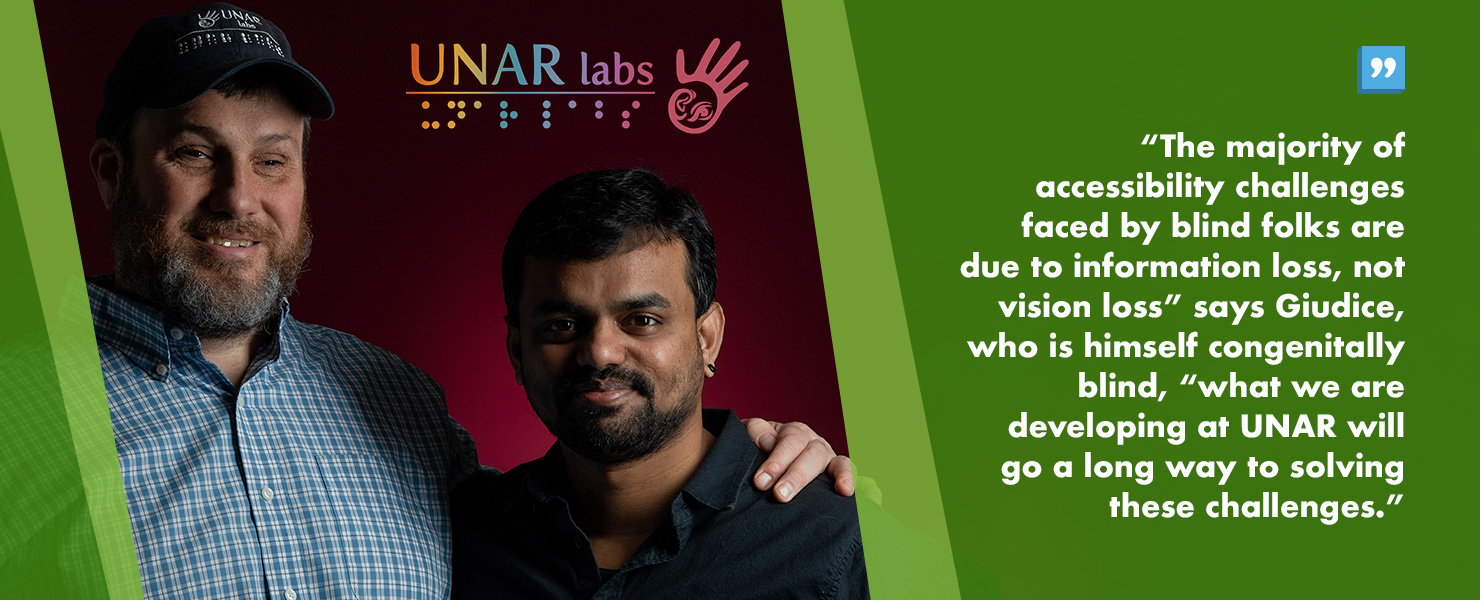Changing the lives of visually-impaired people by enabling digital information access
3 SBIR Awards, Phase I/II NSF, Phase I NIH $1.7M | MTI awards: $100K | Other: $100K

$1.9 million
in non-dilutive R&D funding
Everyone should have access to digital information– regardless of any sensory (dis)abilities. In the United States, there are about 23 million people with visual impairments. Of this population, 70% are unemployed or under-employed, 30% do not travel independently, and only 11% have a college degree. People with visual impairments don’t always have access to critical resources, including digital information.
UNAR (Universal Accessibility Research) was co-founded in 2017 by Dr. Hari Palani and Dr Nicholas Guidice. UNAR empowers people with visual impairments by enabling access to digital information beyond sensory boundaries. While text to speech and braille exist as potential accessibility solutions, the digital translation of charts, graphs and tables has not yet been achieved. Without this important digital translation, it can be difficult for visually impaired people to access data “visualization” in real-time.
Current methods of translation are expensive and static, which contributes to the dramatic inequities visually impaired people face. The co-founders of UNAR developed Midlina to address this gap. Midlina is an innovative software service that helps visually impaired people access digital information. The software translates visual digital information – including images, data charts, and diagrams – into a multi-sensory format, so users can perceive them using audio, speech, touch, and kinesthetic feedback.
To see Midlina enter the market, there were two key challenges UNAR had to overcome. First, there is the technical challenge involved with developing the artificial intelligence (AI) algorithms that will extract, analyze, and transform graphics. Second, ensuring the converted accessible graphic and the product is usable in real-world scenarios. In other words, UNAR needed to show that visually-impaired users would actually benefit from using the software the way it was intentionally designed. UNAR needed to invest in significant Research and Development (R&D) to move forward.
UNAR collaborated with MTI’s TAP (Technical Assistance Program) team to draft a strong proposal for SBIR funding. MTI’s TAP team assisted in various ways, including market identification, commercialization plan development, and financial strategy.
With the help of MTI’s TAP team, UNAR was awarded a Phase I and II from the National Science Foundation (NSF) and a Phase I from the National Institute of Health – National Eye Institute. Initially, the product was thought to have fully addressed and solved the market need through UNAR’s process of iterative design and development. However as part of the NSF’s Phase I, UNAR participated in the NSF Boot Camp, which requires companies to conduct customer discovery. During that effort, UNAR found that the core problem of visually impaired users wasn’t simply graphical access, but overall information access. As a result, they pivoted from the original product idea of a single app to developing a platform technology.
Currently, UNAR is conducting human testing of the beta product and completing a field test the end of Fall 2023. By early 2024, UNAR plans to launch a market-ready version of their platform. In the next three years, they plan to raise $3 million to fund commercialization efforts. Funds will be used to hire additional staff and support business-related costs including customer support expenses, marketing costs, branding costs, marketplace fees, and hosting fees.
